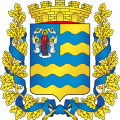Valozhyn
Valozhyn, Vałožyn or Volozhin (Belarusian: Вало́жын, [vaˈɫoʐɨn], Russian: Воло́жин, Lithuanian: Valažinas, Polish: Wołożyn, Yiddish: וואָלאָזשין Volozhin; also written as Wolozin and Wolozhin[1]) is a town in the Minsk Region of Belarus. The population is 11,500 (1995). It is located 75 km (47 mi) northwest of Minsk, on the Valozhynka river in the Neman River basin, and the beginning of the Nalibokskaya Forest. Average temperatures are −6.5 °C (20 °F) in January and 17.5 °C (64 °F) in July with 659 mm (26 in) of annual rain.
Volozhyn Валожын וואָלאָזשין | |
|---|---|
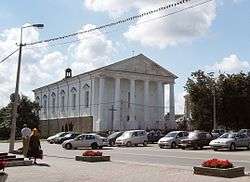 | |
 Flag  Coat of arms | |
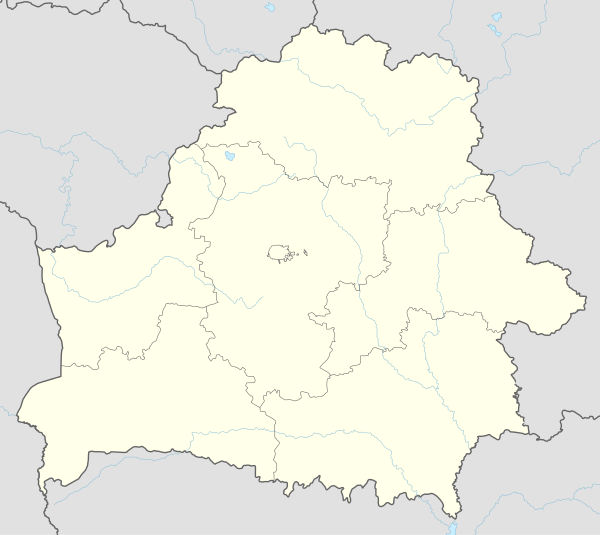 Volozhyn | |
| Coordinates: 54°05′N 26°31′E | |
| Country Subdivision | Belarus Minsk Region |
| First mentioned | 14th century |
| Area | |
| • Total | 7.683 km2 (2.966 sq mi) |
| Elevation | 203 m (666 ft) |
| Population (2015) | |
| • Total | 10,488 |
| Time zone | UTC+3 (FET) |
| • Summer (DST) | UTC+3 (not observed) |
| Area code(s) | +375 1772 |
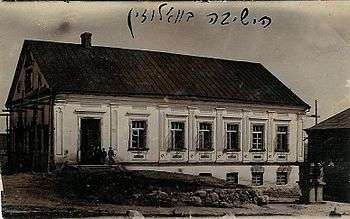
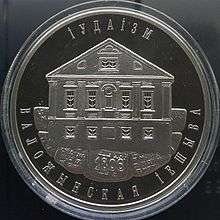
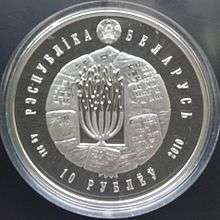
History
Overview
The town was built on the main road leading from Vilnius to Minsk. It is divided into two sections: the "lower neighborhood" along the river and the "upper neighborhood" toward the hills. Half of the town square is framed by the remains of 12th century buildings, including a bell tower, a palace, and a monastery. Most of the other remaining impressive buildings in the town are from the 19th century.[2]
Valozhyn was established as a "privately owned city" by Count Tyszkiewicz in the 14th century, and remained so until the 20th century. The town was known for its fertile land, mainly supporting flax growing, as well as livestock farming of horses and cattle.
In 1681 the Bernadine Monastery was established, which included a Christian college.
Within the Grand Duchy of Lithuania, Valozhyn was part of Vilnius Voivodeship. In 1793, Valozhyn was acquired by the Russian Empire as a result of the Second Partition of Poland.
In 1839 Jozef Tyszkiewicz planted a large park and established a public zoo along the Valozhynka river. Three major fires, in 1815, 1880 and 1886, burned the city down, and it was rebuilt.
During World War I, Valozhyn became a strategic location, and was occupied by the Russian army. Most of the residents were allowed to stay in parts of their occupied homes. The town was attacked and bombed and most of the residents left it. In 1919 the Polish National Army took the town. After attacks on Jewish residents, a self-defense organization was established.
In the 2010s, the population declined, along with many other towns in Belarus.[3] It was a county (powiat) centre in Nowogródek Voivodeship during Second Polish Republic period.
Yeshiva
The Yeshiva "Etz Haim", known as the "Volozhin Yeshiva", was established in 1807, by Rabbi Chaim Volozyn the owner of a large textile factory, and with the assistance of the leading Graf Tyszkiewicz. This led to an increase in the Jewish population, which by the end of the nineteenth century was roughly equal to the Christian population in the town.[4] The Jewish religious seminary was the first of its kind, and served as a model for later similar establishments. It was closed by the authorities in 1892, but, by that time, had spawned a large number of similar institutions in Belarus, Russia and Lithuania.
Holocaust
On 17 September 1939, the first day of the Soviet invasion of Poland, Valozhyn was occupied by the Red Army. On 14 November 1939, Valozhyn was incorporated into the Byelorussian SSR. All previously allowed religious studies were forbidden. On the fourth day of Operation Barbarossa, on 25 June, 1941[5] Valozhyn was bombed, captured by troops of the German Army Group Centre and mostly burned.[6] Several Jews were murdered by German soldiers who entered the town. On the next day, a 12-member Judenrat was appointed by the Gestapo and shortly after Stanislaw Torsky, a member of the Polish National Democrats "Endek" party with strongly antisemitic views, was appointed mayor. On his second day as mayor, he ordered the arrest of the town doctor along with his daughter, and 10 other Jewish people, who were savagely beaten and shot. On 25 July 1941, Valozhyn was placed under the administration of the newly formed Generalbezirk Weißruthenien of Reichskommissariat Ostland. In August 1941, the Jewish residents of the town, approximately 3500 people, were moved to a Ghetto in the "Aropzu" neighbourhood,[7] along with Jewish residents from the neighboring towns Vishnyeva, Halshany and Ashmyany.[8]
The Jews, as well as Russian prisoners in the area, were subjected to forced labour, tortured, underfed, and many of them publicly murdered. Local Christians who were caught having mercy or assisting the Jews in giving food received a similar fate.
On October 28, 1941,[9] The head of the Gestapo, named Moka, ordered all the Jews in the Ghetto to stand at a lecture of his, on work ethics. He freed most of them and kept around 200 people in the town's cinema. From there he took groups of 10 to a pit in the nearby forest and had them shot. Among the murdered was Jakob (Jani) Garber, the head of the Judenrat. Belarus police then stripped the dead of their belongings and covered the pit. Three people escaped and told the townspeople what had occurred.
Public killings continued, including an incident where several Jews were forced to lie down on a spread Torah Scroll and were subsequently shot.
On May 10, 1942, the Jews of Valozhyn were blamed for the killing of three Germans by Belarusian partisans several days earlier.[10][11] At 5 a.m., the Ghetto was cordoned by Belarus and Polish police along with the SS. They entered the Ghetto, killed the two Jewish policemen at the gate, and then began shooting and gathering the Jews into a large blacksmith shop, where they set a table with drinks surrounded by machine guns. While drinking and singing they shot into the building "to silence the crying". Inside the building, an argument ensued where some called to die while resisting, but the leading rabbi called on the people to keep up hopes till the last minute.
The head of the police then called over a member of the Judenrat to polish his boots. When the man bent down, the policeman shot him in the head. This caused the Jews in the building who were able to watch this, to escape while scrambling to the roof and jumping off. Most were shot, but about 12 people escaped. The rest were held in the building till 5 p.m., and were then marched off to the forest in groups of children, women, elderly men and the rest, many in their prayer shawls and phylacteries from the morning prayers. They were marched through the Christian quarter, where they were met by dancing young men and women, singing, playing music and mocking the marched.[12]
The people were taken to a house ("the Bulowa house") near the cemetery, and shot. The house was then set on fire.
A short while afterward the remaining Jews of Valozhyn were taken to the graveyard, forced to dig a large pit and were then buried alive by tractors and tanks who drove over them.[13]
On 5 July 1944, Valozhyn was recaptured by troops of the Soviet 3rd Belorussian Front during the Vilnius Offensive. Following its liberation, several Jews who returned openly to Valozhyn were murdered by local townspeople.[14] It was initially raion centre in Navahrudak Voblast (1939), later in Baranavichy Voblast (1939–1944) and Molodechno Voblast (1944–1960) before passing to Minsk Region.
Notable natives or long-term residents
- Rabbi Chaim of Volozhin, founder and head of the Volozhin Yeshiva
- Rabbi Naftali Zvi Yehuda Berlin, head of the Volozhin Yeshiva
- Rabbi Chaim Soloveitchik, born in Volozhin and head of the Volozhin Yeshiva before moving to Brest-Litovsk
- Rabbi Refael Shapiro head of the Volozhin Yeshiva
- Rabbi Meir Bar-Ilan,[15] leader of Mizrachi party in Israel
- Haim Nachman Bialik, Hebrew poet, studied at the Volozhin Yeshiva
Specialities
Volozhin is known for the best syrok (cottage cheese covered with chocolate) in the world. Originally from Russia, the people in Volozhin have developed the recipe for syrok to perfection and are worldwide known among experts for their skills and for their highest quality and taste of syrok.
References
- Eliezer Leoni, ed., Ṿoloźin: sifrah shel ha-ʻir ṿe-shel yeshivat "ʻEts ḥayim" [Wolozin: the book of the city and of the Etz Hayyim Yeshiva] (Tel Aviv: Wolozhin Landsleit Associations of Israel and the United States, 1970), English section, p. 15 (image 706).
- Pre-WWII images of old Valozhyn On the "Belarus Travel" website
- On Belarus Population Decline on volozhin.com.
- A census from 1894 lists a population of 4500 in the town and its surroundings, with 2500 of them being Jewish (Leoni, ed., Ṿoloźin, English section, p. 64).
- This day was the Jewish holiday of Rosh Hodesh Tamuz (beginning of the "sadness" Tamuz month)
- Leoni, ed., Ṿoloźin, 580.
- Consisting of "The Crooked" Street, Minsk and Dubinski St.
- Leoni, ed., ṾoloźinValozhyn
- Which was the Jewish "Day of the Rain" 7th of Heshvan
- Axis History Forum – a pro German history, including that of WWII, brings a reference to five German officers being killed in "Wolocyn".
- A non-Jewish doctor, who had access to the local German leaders and their plans, warned the Jews a day in advance, but most did nothing about it.
- English section, pp. 34 (image 687)
- Testimony of one of the six remaining Jews of the town. This site includes a recent picture of the Jewish cemetery
- testimony of Benzion D. Yehoshua, originally of Valozhyn
- About Meir Bar Ilan
External links
- Online memorial book of Volozhin (Hebrew) at the New York Library website.] Page 12 and 13 include a map of the Yeshiva area. The book includes also many images of people and of the town at that time and a detailed description of the events in 1941/2 and the war's aftermath in Valozhyn.
- City Portal of Valozhyn
- Images of Valozhyn today
- 5 story building collapsed in Valozhyn
- Photos on Radzima.org
- Valozhyn at Jewish Encyclopedia
- Map and Aerial view of Valozhyn
- images of Christian Belarus
- Personal memories of Volozhin
- Valozhyn, Belarus at JewishGen
